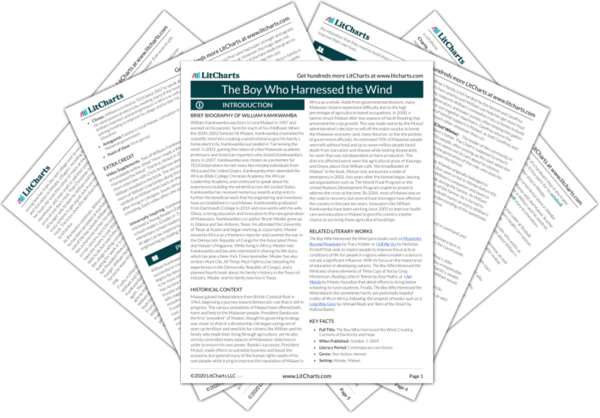Rebirth, Recycling, and Reinvention
Throughout the book, William focuses on the way that new life can come from things that were seemingly useless or even dead. He applies the concepts of rebirth and recycling to objects in his village, the Malawian landscape, and the people of Malawi. This principle of rebirth and recycling is most visible in William’s windmill, which is made up of spare parts and old materials that others threw away. William sees the potential in…
read analysis of Rebirth, Recycling, and ReinventionThe Business of Survival
Many of William’s inventions are focused on helping people survive and thrive in Malawi and Africa at large. He sees survival as a business where difficulties must be balanced out with ingenuity and hard work. Malawi’s farmers, though incredibly hard-working, are stuck in a vicious cycle wherein they barely survive each year and are unable to plan or save for the future. William wants to disrupt the damaging equation of work and loss that…
read analysis of The Business of SurvivalMalawian Culture and African Community
William describes many elements of Malawian culture as seen in his rural village and the glimpses he has of Malawian cities, commenting on both the similarities and differences to American life and culture. Throughout the novel, William notes how life in Malawi and America is different, but shows that people are much the same in Malawi and America. In America, William describes his shock at many things that Americans take for granted, such as elevators…
read analysis of Malawian Culture and African Community
Education and Entrepreneurship
William and his family place a huge value on education, as one of the only ways for a rural Malawian to improve his or her life. Though the actual conditions of William’s primary school are dismal due to over-crowding and under-funding, William focuses on the positive aspects of gaining an education. When William’s grades are not enough to gain entry into a top-tier, government-favored secondary school, William applies himself to learning as much as he…
read analysis of Education and EntrepreneurshipScience vs. Superstition and Magic
Science and superstition are at first at odds in the novel, as William tries to implement advances in science and leave behind the old magic beliefs. As William learns more about the scientific principles at work in the world, he believes less in magic that works good and evil upon people. Science improves William’s life, both physically in his inventions and emotionally in the confidence that William gains in himself free from the threat of…
read analysis of Science vs. Superstition and Magic











